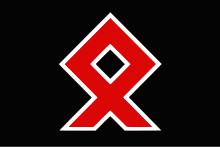Wiking-Jugend

The "Wiking-Jugend" (WJ, "Viking youth") was a German Neo-Nazi organization modeled on the Hitlerjugend.
Wiking Youth emerged in 1952 from a merger of several German right-wing extremist youth groups. In 1994 it was banned by the Federal Ministry of the Interior. At that time it had 400 to 500 members and was considered the largest Neo-Nazi youth organization in Germany.[1]
History
[edit]The Sozialistische Reichspartei (SRP) was outlawed in 1952, together with its youth organization "Reichsjugend". The Neo-Nazis went underground in numerous fragmented follow-up organizations, and the former Reichsjugend, the Vaterländischer Jungenbund and the Deutsche Unitarier-Jugend eventually coalesced again in the form of the "Wiking-Jugend". The group was active in the pan-European nationalist New European Order, although they quit in 1955 over the issue of South Tyrol.
The organization was founded by Walter Matthaei, and thereafter took on a dynastic tendency, being headed in turn by Raoul Nahrath, then his son Wolfgang, and then his son Wolfram.[2][3]
Until 1991, Stolberg (Rhineland) was the headquarters of the WJ. From 1991 to 1994, it was in Berlin. There was a direct connection to the NPD. At times the Wiking Youth and the NPD youth organization has a registered under the address of the former WJ chairman Wolfgang Nahraths. When the WJ was banned in 1994, the JN served as a catch basin for numerous former WJ members.[1]
The Wiking-Jugend was outlawed as unconstitutional on 10 November 1994 by the North Rhine-Westphalian Ministry of the Interior.[4] The successor organization was the Heimattreue Deutsche Jugend (Homeland-loyal German Youth) (HDJ), which follows the WJ tradition. It was also banned in March 2009.[1]
Structure
[edit]The structure of the WJ was strongly based on the National Socialist Hitler Youth: subunits were "Gaue" and "Forste", the children and teens were organized separately according to gender into boys' and girls' groups. The minimum age for membership was six years. There was no upper age limit; membership was for life.
The WJ pursued the intention of training its members in National Socialist idology and socializing them in a nationalistic way. It regularly organized camps and marches, which also intend as a paramilitary training. According to the WJ, a total of 15,000 children and young people are said to have completed their school.[1]
Members
[edit]Well known members:
See also
[edit]References
[edit]- ^ a b c d Bildung, Bundeszentrale für politische. "Wiking-Jugend". bpb.de (in German). Retrieved 2024-05-27.
- ^ Grumke, Thomas; Wagner, Bernd (2002). Handbuch Rechtsradikalismus : Personen, Organisationen, Netzwerke : vom Neonazismus bis in die Mitte der Gesellschaft (in German). Opladen: Leske + Budrich. ISBN 3-8100-3399-5. OCLC 50921274.
- ^ Braun, Stephan; Geisler, Alexander; Gerster, Martin (2010-11-17). Strategien der extremen Rechten: Hintergründe - Analysen - Antworten (in German). Springer-Verlag. p. 384. ISBN 978-3-531-91708-5.
- ^ "Verbot des Vereins Wiking-Jugend e.V." (in German). North Rhine-Westphalian Ministry of the Interior. 1994-12-02. Retrieved 25 September 2017.
- ^ a b c d e f g h Antifaschistisches Pressearchiv und Bildungszentrum Berlin: Profil: Wiking Jugend e.V. (WJ)
- ^ a b c d e Andrea Röpke: Ferien im Führerbunker. Die neonazistische Kindererziehung der „Heimattreuen Deutschen Jugend (HDJ)“. 2. Auflage. Bildungsvereinigung Arbeit und Leben, Braunschweig 2008, ISBN 978-3-932082-32-0, S. 29.
- ^ Yury Winterberg: Der Rebell. Odfried Hepp – Neonazi, Terrorist, Aussteiger. Gustav Lübbe Verlag, Bergisch Gladbach 2004, ISBN 3-7857-2160-9, S. 47 ff. und 59 ff.
- ^ Andrea Röpke: Ferien im Führerbunker. Die neonazistische Kindererziehung der „Heimattreuen Deutschen Jugend (HDJ)“. 2. Auflage. Bildungsvereinigung Arbeit und Leben, Braunschweig 2008, ISBN 978-3-932082-32-0, S. 87 f.
- ^ Andrea Röpke: Ferien im Führerbunker. Die neonazistische Kindererziehung der „Heimattreuen Deutschen Jugend (HDJ)“. 2. Auflage. Bildungsvereinigung Arbeit und Leben, Braunschweig 2008, ISBN 978-3-932082-32-0, S. 10.
- ^ Andrea Röpke: Ferien im Führerbunker. Die neonazistische Kindererziehung der „Heimattreuen Deutschen Jugend (HDJ)“. 2. Auflage. Bildungsvereinigung Arbeit und Leben, Braunschweig 2008, ISBN 978-3-932082-32-0, S. 39 ff.
- ^ Gideon Botsch: Die extreme Rechte in der Bundesrepublik Deutschland 1949 bis heute. Wissenschaftliche Buchgesellschaft, Darmstadt 2012, ISBN 978-3-534-23832-3, S. 131.
- ^ Andrea Röpke: Ferien im Führerbunker. Die neonazistische Kindererziehung der „Heimattreuen Deutschen Jugend (HDJ)“. 2. Auflage. Bildungsvereinigung Arbeit und Leben, Braunschweig 2008, ISBN 978-3-932082-32-0, S. 38.
